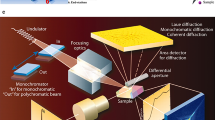Abstract
IT is known that X-ray line broadening in cold-worked metals appears to tend towards a limiting value as the amount of deformation increases. A possible cause of this might be self-annealing. If, as is very probable, line broadening is due mainly to internal strains, self-annealing would lead to strain release or recrystallization as soon as the internal strains reach a critical magnitude, which, of course, would depend on the temperature.
Similar content being viewed by others
References
Hutchison, T. S., Nature, 162, 374 (1948).
van Arkel, A. E., Physica, 5, 208 (1925).
Megaw, H. D., and Stokes, A. R., J. Inst. Metals, 71, 279 (1945).
Orowan, E., Z. Phys., 89, 640 ff. (1934); Symposium on Internal Stresses, London, 1947, p. 53 (Inst. of Metals, 1948).
Frank, F. C., Conference on Strength of Solids, Bristol, 1947, p. 48 (Phys. Soc., 1948).
Obreimow, I. W., and Schubnikoff, L. W., Z. Phys., 41, 907 (1927).
Nye, J. F., Nature, 161, 367 (1948); and results to be published.
See Orowan, E., West of Scotland Iron and Steel Inst., 45 (Feb. 1947).
Author information
Authors and Affiliations
Rights and permissions
About this article
Cite this article
PATERSON, M., OROWAN, E. X-Ray Line Broadening in Cold-worked Metals. Nature 162, 991–992 (1948). https://doi.org/10.1038/162991a0
Issue Date:
DOI: https://doi.org/10.1038/162991a0
- Springer Nature Limited





